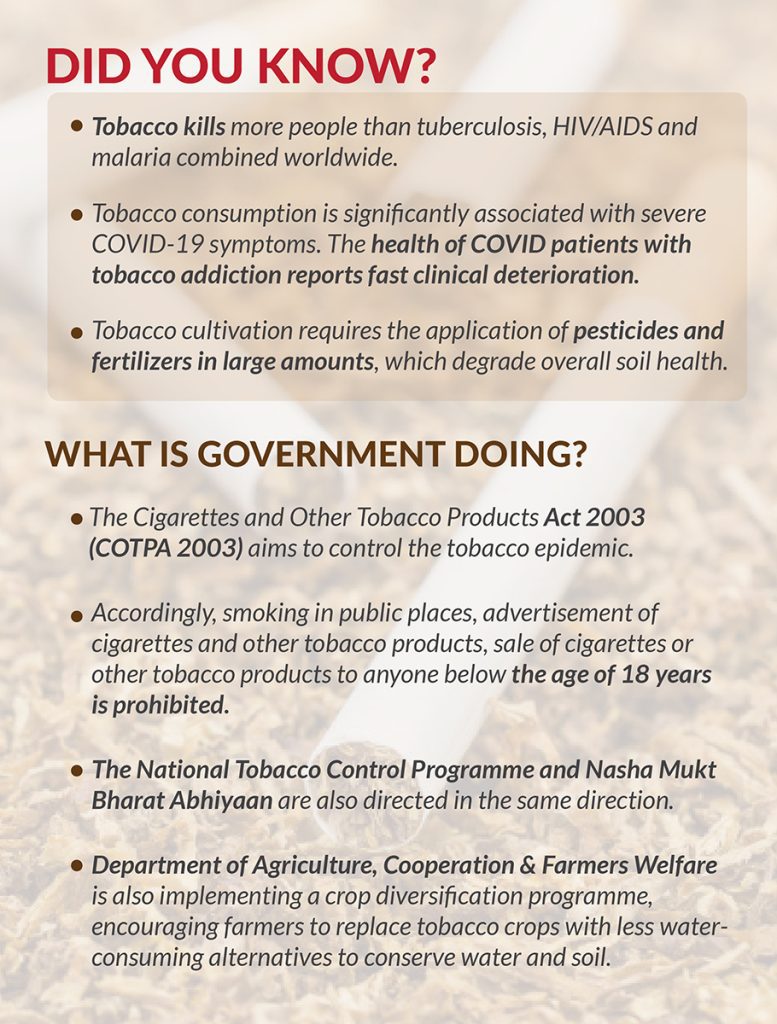
Not just humans, tobacco takes a huge toll on environment, too

Year after year, tobacco is emerging as a bigger health hazard than ever before. Its consumption is not just harmful for the human body, but for the environment too, with the damaging effects ranging from soil infertility to water wastage to air pollution.
Here is how tobacco takes a toll on environment:
Massive land clearance required
As per the World Health Organisation (WHO), about 3.5 million hectares of land is cleared for growing tobacco each year. It causes deforestation, mainly in developing nations. Tobacco cultivation results in soil degradation, making it infertile to support the growth of other crops or vegetation.
Additionally, tobacco contributes 84 megatons of the greenhouse gas carbon dioxide to the atmosphere every year. That apart, around 22 billion litres of water is consumed in the production of cigarettes every year.
29% Indian adults consume tobacco
The situation is no different in India, where tobacco is one of the important cash crops. Today, India is the second-largest crop producer in the world after China. According to the Central Tobacco Research Centre (CTRI) of the Indian Council of Agricultural Research (ICAR), around 760 million kg of tobacco is grown in India on about 40 lakh hectares of land. The sector provides jobs to millions of people and contributes as much as ₹22,737 crore as excise duty and ₹5,969 crore in foreign exchange to the national treasury.
But a massive cost of tobacco cultivation is paid for by the country’s environment and people’s health. A report by the Ministry of Health and Family Welfare says, “The total economic costs attributable to tobacco use from all diseases in India in the year 2011 for persons aged 35-69 (years) amounted to ₹1,04,500 crore.”

It is estimated that about 29 per cent of the adult Indian population consumes tobacco. Most commonly, it is consumed as Smokeless Tobacco Products (SLT) like ‘khaini’, ‘gutkha’, and ‘zarda’. Smoking forms of tobacco are used as ‘bidi’, cigarette, ‘hookah’, etc. The smokeless forms pose high risks of oral and oesophageal cancer. Their consumption by pregnant women can also lead to stillbirth and low birth weight in infants. People addicted to smoking are, on the other hand, at very high risk of lung, oral cavity, pharynx, nasal cavity, larynx, esophagus, stomach, pancreas, liver, kidney, ureter, urinary bladder, uterine cervix, and bone marrow cancers.
Also read: Monkeypox is no COVID, but Indian experts are being abundantly cautious
Tobacco kills more people than tuberculosis, HIV/AIDS, and malaria combined worldwide. It has also been reported that tobacco consumption in both smoking and chewing forms is significantly associated with severe COVID-19 symptoms. Tobacco users’ pre-existing health conditions, such as respiratory and cardiovascular disease, were observed to exacerbate disease symptoms, making treatment of COVID-19 patients more difficult owing to their fast clinical deterioration.
Rapid depletion of soil nutrients
The environmental impacts of tobacco cultivation also add to India’s enormous economic burden. Tobacco is a very nutrient-hungry crop, and it depletes soil nutrients more rapidly. Tobacco cultivation requires the application of pesticides and fertilisers in large amounts, which degrade overall soil health. Tobacco cultivation results in soil erosion because it is typically grown as a monocrop (the practice of cultivating a single crop on the same farmland year after year), exposing the topsoil to wind and water.
Green tobacco sickness
Besides, health risks are associated even with tobacco cultivation apart from consumption. Tobacco farmers are prone to suffering from a work-related ailment known as “Green Tobacco Sickness”, which is caused mainly by nicotine absorption via the skin. Nicotine is an addictive chemical found in tobacco.
Studies conducted by the National Institute of Occupational Health (NIOH) on CTRI farms in Andhra Pradesh reveal discoloration of workers’ skin after coming into contact with tobacco leaves. Headache, nausea/vomiting, dizziness, lack of appetite, exhaustion, and weakness are all signs of Green Tobacco Sickness, which can be caused even by tobacco storage in houses.
Also read: Pollution kills 9 mn people a year; nearly a quarter are from India: Lancet study
The WHO’s this year’s campaign on “Tobacco: Threat to our Environment” urges governments and policymakers to strengthen legislation and implementation of existing schemes that hold tobacco companies accountable for the environmental and economic costs of waste tobacco products.


